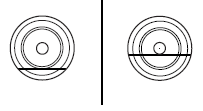Driving through water


If driving through deep or standing water is unavoidable, proceed very slowly. Never drive through water that is higher than the bottom of the wheel rims (for cars) or the bottom of the hubs (for trucks).
When driving through water, traction or brake capability may be limited.
Also, water may enter your engine’s air intake and severely damage your engine or your vehicle may stall. Driving through deep water where the transmission vent tube is submerged may allow water into the transmission and cause internal transmission damage.
Once through the water, always dry the brakes by moving your vehicle slowly while applying light pressure on the brake pedal.
Wet brakes do not stop the vehicle as quickly as dry brakes.
See also:
Illuminated entry
The interior lamps, parking lamps and puddle lamps (if equipped)
illuminate when the IA key or the keyless entry keypad is used to unlock
the door(s).
The illuminated entry system will turn off ...
Rear seat head restraints
Your vehicle is equipped with rear seat outboard head restraints that
look differently than the front head restraints, but function similarly.
WARNING: To minimize the risk of neck injury in the ev ...
How does the Personal Safety System work?
The Personal Safety System can adapt the deployment strategy of your
vehicle’s safety devices according to crash severity and occupant
conditions. A collection of crash and occupant sensors provid ...
